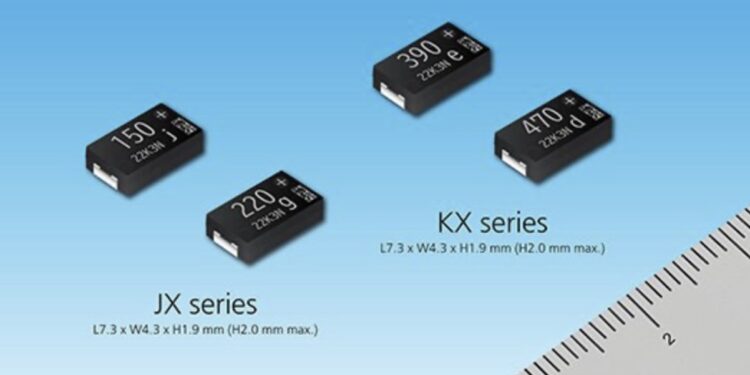Panasonic Corporation releases the KX Series SP-Cap® conductive polymer aluminum electrolytic capacitors with industry’s longest 5,500 hours of endurance life time.
Panasonic Corporation announced today that its Industry Company has commercialized the KX series of SP-Cap® conductive polymer aluminum electrolytic capacitors[1] with the highest level of reliability in the industry – up to 5,500 hours of endurance at 125°C. This new series of capacitors is suitable for use in power circuits for servers and communication base stations, etc. that require capacitors with a higher durability for high-speed communications. Mass production of the new capacitors will start in April 2022.
Panasonic pursues even higher endurance performance in the development of conductive polymer aluminum electrolytic capacitors. With the combination of its proprietary conductive polymer forming technology and manufacturing process technology, the company has commercialized the KX series of SP-Cap® with the industry’s longest endurance*1 of 5,500 hours at 125°C, 1.8 times the lifetime of the JX series SP-Cap®.
Panasonic has also expanded the JX series SP-Cap® product lineup with low-ESR[2] products and an added range of rated voltages.
Furthermore, both the KX and JX series of SP-Cap® guarantee long endurance even under high temperature and high humidity conditions – 1,000 hours at 85°C/85% (dump-heat steady state).
Panasonic contributes to stabilizing power supply circuits through the development of conductive polymer aluminum electrolytic capacitors that feature low ESR and excellent large capacitance characteristics.
Applications:
Output-side of low voltage power rail in power supply circuits employed in the ICT infrastructure industries such as communication base stations, servers, etc.
Features:
- Achieving the Industry’s Longest*1 5,500 Hours of Endurance at 125°C: KX series SP-Cap®Panasonic’s SP-Cap® capacitors adopt a stacking structure of capacitor elements using aluminum electrode foils. With the combination of the company’s proprietary conductive polymer forming technology and manufacturing process technology, the KX series SP-Cap® capacitors achieve high reliability with endurance of 5,500 hours at 125°C – 1.8 times the lifetime of the JX series SP-Cap®.
- Product lineup expansion with addition of low-ESR products and a further variety of rated voltages: JX series SP-Cap®. Panasonic has added products with ESR of 3/4.5 mΩ (100 kHz) to the 2 V and 2.5 V product lineups (currently, 9 mΩ / 100 kHz) as well as increasing the variety of rated voltages by adding 4 V and 6.3 V products (currently 2 V and 2.5 V). These products will facilitate equipment design with long endurance, contributing to performance improvements.
- Space-saving and lowering environmental impact. The newly developed capacitors, with an effective capacitance equivalent to that of MLCCs, enable a reduction in the number of required capacitors. Replacing multiple MLCCs with an SP-Cap® capacitor will reduce mounting areas and enable the miniaturization of equipment, thereby lowering environmental impact through the reduction of materials used.
Basic specifications:
KX series SP-Cap®
- Rated Voltage: 2-2.5V
- Capacitance: 220 – 470 μF
- Category temperature range: -55°C to +125°C
- Endurance: 125°C 5,500 hours
- ESR: 9 mΩ max.(100 kHz/+20℃)
- Dimensions: L7.3 mm x W4.3 mm x H1.9 mm
JX series SP-Cap®
- Rated Voltage: 2-6.3V
- Capacitance: 120 – 470 μF
- Category temperature range: -55°C to +125°C
- Endurance: 125°C 3,000 hours
- ESR: 3-15 mΩ max.(100 kHz/+20℃)
- Dimensions: L7.3 mm x W4.3 mm x H1.9 mm
Term Descriptions:
- Conductive polymer aluminum electrolytic capacitors. A collective term for aluminum electrolytic capacitors that use a conductive polymer, which is a solid electrolyte, instead of an electrolytic solution. There are two types of structures: the wound type, as used in conventional aluminum electrolytic capacitors, and the stacking type. Conductive polymers have high conductivity and excellent low ESR characteristics. *SP-Cap® is a registered trademark of Panasonic Corporation.
- ESR (Equivalent Series Resistance). ESR stands for equivalent series resistance, which is a resistance component on the equivalent circuit of electrolytic capacitors. Capacitors with a lower ESR value allow more ripple currents, as well as exhibiting excellent noise absorption.


































